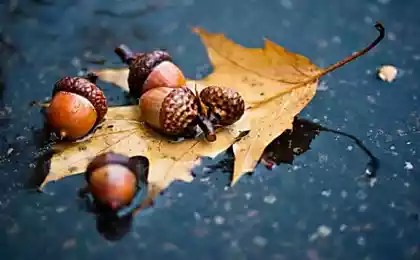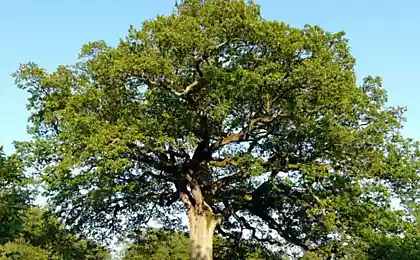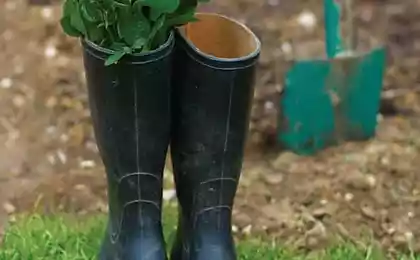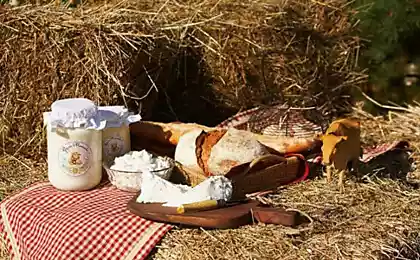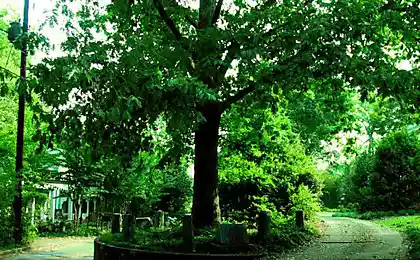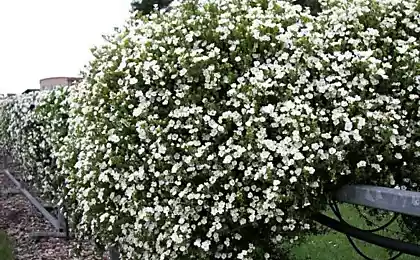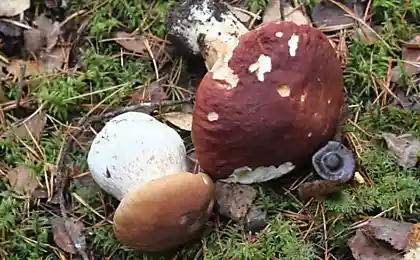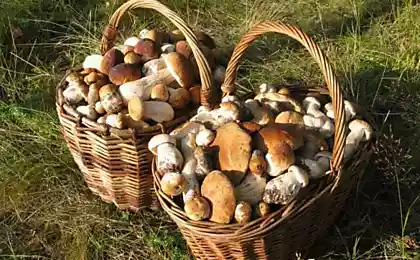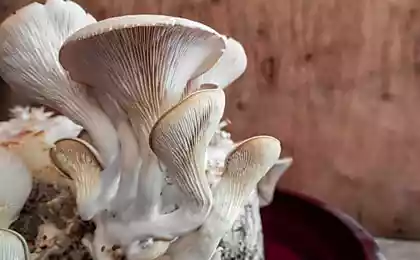677
How to grow an oak from an acorn
Oak is one of the most long-lived trees in Russia. Within its range it is able to grow in different soil conditions, but grows well only when a sufficient richness of the soil. In some conditions the possible seeding of oak acorns in a permanent place.In a plant nursery growing seedlings is a major one or two years, sometimes three.
The English oak is grown in the state forest nurseries in some regions, it is possible to purchase a one-year seedlings of oak (of which one or two of the year can grow large seedlings).
Oak acorns in contrast to the seeds of the vast majority of our other trees do not remain viable upon drying and prolonged storage at room temperature. Therefore, it is necessary to sow them in the autumn before snow falls and freezing of the soil, or to provide special storage conditions. Autumn sowing is the most simple, but there is a serious risk of damage to the acorns by rodents.
Twenty one million two hundred two thousand nine hundred twenty nine
For spring sowing acorns to properly save. The best storage conditions are created at low (around 0° or slightly higher) temperatures, high humidity and moderate ventilation. Acorns can be stored in the basement, which is well maintained in winter potatoes; can also be added dropwise them fall into the soil to a depth of at least 20 cm, closing the top with a sheet of waterproof material, leaving between this leaf and acorns with a layer of air and providing protection from mice.
In any case, to lay in winter storage have a healthy acorns without signs of damage, preferably collected in dry weather, and dried at room temperature for weeks. Any special training survived the winter of seeds before sowing is not necessary.
Before sowing rate the quality of acorns, and open a few of them. Live acorns have yellow cotyledons, and in place of their connection with each other, you'll live (yellow or red-yellow) of the embryo. The dead acorns inside black or grey. On external signs it is not always possible to distinguish live from dead acorns. Satisfactory results are obtained by soaking the acorns in water containers, the dead acorns mostly out, live in the main sink (if a lot of acorns, this way of separating the dead from the living, it is possible to recommend, but a small part of the living acorns will be lost).
If you are unable to stock up on acorns in the autumn in some years (after the big crop of acorns and provided "crop failure" of mice and if the winter was not very cold) you can dial in the spring of the living and germinating acorns in the nearby woods or Park. To collect germinating acorns have an early spring, almost immediately after the snow melts, otherwise many acorns you find damaged roots.
Collected acorns need or sow or store before planting so that the roots don't dry out (for example, mixed with wet leaves in a plastic box, tucked away in a refrigerator or cool basement). Even for short-term storage, it is necessary to keep the germinating acorns are not moldy (damaged gets thrown away), and to provide ventilation. The quicker you can plant the collected acorns in the spring, the greater part of them will be able to develop into seedlings.
When sowing acorns in the garden spaced parallel grooves at a distance of 15-25 cm from each other. Place the acorns in the furrows from the calculation of 15-50 pieces per 1 m length of the furrow, depending on quality and size (if acorns are large and almost all live, then they must be put less, if small and with a large proportion of dead and questionable – thick). If you plan to plant in a permanent place a one-year seedlings of oak, the acorns should be sown even less – at a distance of 7-10 cm from each other (this will ensure maximum growth of each tree). Push the acorns into the bottom of the furrows so that they were at a depth of 2-3 cm relative to the soil surface at spring planting and 3-6 cm in autumn. Then zarovnaya furrow, covering the acorns with soil.
Acorns germinate for very long. First, they develop a strong root reaching a length of several tens of centimeters, and only then begins to grow a stalk. Therefore, the oak sprouts may appear on the surface of the soil only a month and a half after the beginning of germination. Do not rush to conclude that your oaks were killed, and dig a bed with crops (as the experience of novice foresters-lovers, it happens). If you have doubts, try to collect some acorns. If the roots have grown, so acorns alive.
How to grow oak.
The cultivation of oak. Creating a nursery for seedlings of Oak trees are often damaged by powdery mildew. As a rule, this disease does not lead to death, but can slow their growth. At strong development of mealy dew annual oaks can be sprayed one percent solution of copper sulfate or colloidal sulfur solution of the same concentration.
Sixty two million three hundred forty three thousand three hundred eighty eight
The sprouts of oak are much less suffer from weeds and drying out of the soil than seedlings of coniferous trees (thanks to the stock of nutrients in the acorn immediately develop large roots and leaves). However, always try to keep crops free from weeds and provide irrigation during severe drought, especially in the case if you want to get large seedlings in one year.
Stop all sorts of extra watering for about a month and a half before the time when your area begins a massive leaf which will allow oak seedlings to better prepare for winter (too late growths of oak are often destroyed by frost in winter). In summer, the oak seedlings are often affected by powdery mildew – fungal disease. Powdery mildew cannot kill the seedlings of oak, but can significantly reduce their growth.
At strong development of mealy dew (if a white film will cover over half of the area of all leaves) the seedlings can handle a 1 % solution of copper sulphate or 1 % of the same suspension of sulfur. Saplings can be grown for two years in one place without a transplant, and can be transplanted for the second year in "school". The second method is preferable because it allows you to form a more compact and branched root system, which suffers less when transplanting to a permanent place (two-year seedlings grown without a transplant, the length of the main root can be more than a meter, and transplant them without damaging the root).
Transplant seedlings in the "school" should be made in the spring, preferably as early as possible to damaged when transplanting, the root system has had time to partially recover before the leaves come out (it is also important that the soil at the time of transplant was still wet). When transplanting, cut the main root of each seedling at a distance of 15-20 cm from the place where the acorn (most of the remnants of acorn seedlings in the second year can still be seen). This will help to form a more compact root system. Can the main root is cut, but in this case it will be very difficult to dig out seedlings already two years without serious damage to their root system.
In the "new" position the rows of seedlings at a distance of 25-30 cm from each other, and the seedlings in row – 12-15 cm When planting each seedling make a stake or shovel handle holes with a depth of 20-25 cm (the depth of the pit should be such that when planting the seedling the place of attachment of the acorn was at 2-3 cm below the soil surface). Insert the seedlings in the holes (the main root of the oak seedlings, in contrast to root conifers, solid and straight and inserted in the holes without any problems). Then fill the holes with earth and compact it with your hands so the earth is denser close to the roots of seedlings.
The transplanted seedlings in the first weeks after transplantation suffer from root damage is leaf breaking is relatively slow and shoot growth is relatively small. However, by the middle of summer normal development of the seedlings recovered, and by the fall, tend to get large and are quite suitable for planting in a permanent place of seedlings (height 30-50 cm). If the size of seedlings of the autumn leaves much to be desired, then the transplant can take only the largest, and leave the rest in the "school" for another year.
If you are transplanted to a permanent place annual oak seedlings (this is possible if planting is done on areas with low grass cover or on the plowed soil), do not cut the main roots of the seedlings – try to keep as much of their length. The root system of annual seedling oak is represented mainly long and straight taproot with weak and short lateral roots, so transplant enough to do an adequate depth of a narrow hole with a stake or a shovel.
Oaks (Quercus) are Central components of trees in different forests. Bur oak (Quercus macrocarpa) and white oak (Quercus alba) to give a tasty acorns, with minimal training, you can get an edible acorn flour. Other species of oaks also provide acorns, but they need more processing to make them edible.
The space under the widely spreading branches of the oak tree is a great place to grow shade-tolerant species. One possibility is a three-blade pawpaw (Asimina triloba), is only relative to temperate tropical cream Apple. The so-called banana tree. Pawpaw is a deciduous tree reaching in favourable conditions a few meters (at home about 12 meters); easily formed in a dwarf form. In September — October fruits ripen. It's juicy berries, cylindrical shape, with curled ends that reach 12 cm in length and 5 cm in diameter, collected in the stems.
Areas near the edges of the crown oaks, where enough sunlight for other species such as hazel (Corylus) and oblong quince (Cydonia oblongata). Open areas with half-light niches for berry bushes, such as gooseberry (Ribes uva-crisp), red and black currant (Ribes nigrum & Ribes rubrum).
Perennials: comfrey (Symphytum officinale) and horseradish (Armoracia rusticana) accumulate nutrients in leaves and after their death give them to the soil, they can mulch bushes and trees. Comfrey has medicinal properties and is used to feed livestock, horseradish makes a wonderful seasoning.
Borage (Borago officinalis) bee attractant attracts bees, and thus has a beneficial effect on strawberries. The bright blue flowers of borage is edible with a pleasant cucumber scent. Its seeds are the source of fatty acid GLA. Borage will samosels planted it once, you can get the seedlings in future years.
Strawberry (Fragaria x ananassa) as ground cover can fill in the rest of the solar space. Strawberries can be replaced with raspberry (Rubus arcticus), 10-15 cm in height. For shaded areas apply wild ginger – wild ginger (Asarum canadense).
How to grow an oak from an acorn
To grow the acorns at home is quite fun and entertaining. First you need sort high quality and healthy acorns. The size of the acorn is not important, germinate well and the smallest acorns. But I would advise to collect acorns under healthy and large oak trees. In my opinion the chances of good progeny at oak more than the tiny man in the shadows. Inspect the acorn in the presence of mold and damage. If you plant an acorn covered with mold, it can then spread and on the sprouted tree. The presence of the cap of the acorn is totally irrelevant.
Rinse the acorns under cool running water with soap. This is done to remove the acorn larvae of any parasites and mold spores.
Some advise to collect from acorns because the acorns Pareil winter, and thus they are stronger than their counterparts. But I want to add that the city last year acorns in the parks is almost impossible to find – all of them eats crow.
How to germinate an acorn.
Germinate the acorns in several ways. The easiest just throw in a saucer with water and ostvit on the windowsill.
If you are interested in the process of germination of the acorn, you can put an acorn in a cloth (cheesecloth or sock) and squirt water. Cloth must remain damp.
If you want to avoid hassle, then immediately plant the acorn in the ground. Will fit any ground, but preferably the one that sold for planting flowers.
Oaks do not grow well in clay and sand. Or rather almost do not grow. Oak likes moist, loose, fertile land deciduous forest.
How to quickly grow an acorn.
And in wet cotton wool and directly in the ground acorns grow equally fast. 2-3 weeks required to see a powerful germ. Don't forget to water the acorns! They absorb water very quickly! Water the sprouts every day!
What to grow an Oak tree.
From other trees, oaks have a powerful root system, do not expect to grow strong tree in a small pot. If you plan to grow is large enough to house a tree, be large and deep tubs.
If your dubchek suddenly in the middle of winter withered and died – not in a hurry to throw it away! Maybe he just figured out your plan and understand that it is winter! Wait until spring and it is possible that your pet will come to life again!
When trees become crowded in the tub – you put it in the ground, preparing his landing in a hole filled with black earth! published
P. S. And remember, only by changing their consumption — together we change the world! ©
Join us in Facebook , Vkontakte, Odnoklassniki
Source: vse-svoe.com/?p=3822
The English oak is grown in the state forest nurseries in some regions, it is possible to purchase a one-year seedlings of oak (of which one or two of the year can grow large seedlings).
Oak acorns in contrast to the seeds of the vast majority of our other trees do not remain viable upon drying and prolonged storage at room temperature. Therefore, it is necessary to sow them in the autumn before snow falls and freezing of the soil, or to provide special storage conditions. Autumn sowing is the most simple, but there is a serious risk of damage to the acorns by rodents.
Twenty one million two hundred two thousand nine hundred twenty nine
For spring sowing acorns to properly save. The best storage conditions are created at low (around 0° or slightly higher) temperatures, high humidity and moderate ventilation. Acorns can be stored in the basement, which is well maintained in winter potatoes; can also be added dropwise them fall into the soil to a depth of at least 20 cm, closing the top with a sheet of waterproof material, leaving between this leaf and acorns with a layer of air and providing protection from mice.
In any case, to lay in winter storage have a healthy acorns without signs of damage, preferably collected in dry weather, and dried at room temperature for weeks. Any special training survived the winter of seeds before sowing is not necessary.
Before sowing rate the quality of acorns, and open a few of them. Live acorns have yellow cotyledons, and in place of their connection with each other, you'll live (yellow or red-yellow) of the embryo. The dead acorns inside black or grey. On external signs it is not always possible to distinguish live from dead acorns. Satisfactory results are obtained by soaking the acorns in water containers, the dead acorns mostly out, live in the main sink (if a lot of acorns, this way of separating the dead from the living, it is possible to recommend, but a small part of the living acorns will be lost).
If you are unable to stock up on acorns in the autumn in some years (after the big crop of acorns and provided "crop failure" of mice and if the winter was not very cold) you can dial in the spring of the living and germinating acorns in the nearby woods or Park. To collect germinating acorns have an early spring, almost immediately after the snow melts, otherwise many acorns you find damaged roots.
Collected acorns need or sow or store before planting so that the roots don't dry out (for example, mixed with wet leaves in a plastic box, tucked away in a refrigerator or cool basement). Even for short-term storage, it is necessary to keep the germinating acorns are not moldy (damaged gets thrown away), and to provide ventilation. The quicker you can plant the collected acorns in the spring, the greater part of them will be able to develop into seedlings.
When sowing acorns in the garden spaced parallel grooves at a distance of 15-25 cm from each other. Place the acorns in the furrows from the calculation of 15-50 pieces per 1 m length of the furrow, depending on quality and size (if acorns are large and almost all live, then they must be put less, if small and with a large proportion of dead and questionable – thick). If you plan to plant in a permanent place a one-year seedlings of oak, the acorns should be sown even less – at a distance of 7-10 cm from each other (this will ensure maximum growth of each tree). Push the acorns into the bottom of the furrows so that they were at a depth of 2-3 cm relative to the soil surface at spring planting and 3-6 cm in autumn. Then zarovnaya furrow, covering the acorns with soil.
Acorns germinate for very long. First, they develop a strong root reaching a length of several tens of centimeters, and only then begins to grow a stalk. Therefore, the oak sprouts may appear on the surface of the soil only a month and a half after the beginning of germination. Do not rush to conclude that your oaks were killed, and dig a bed with crops (as the experience of novice foresters-lovers, it happens). If you have doubts, try to collect some acorns. If the roots have grown, so acorns alive.
How to grow oak.
The cultivation of oak. Creating a nursery for seedlings of Oak trees are often damaged by powdery mildew. As a rule, this disease does not lead to death, but can slow their growth. At strong development of mealy dew annual oaks can be sprayed one percent solution of copper sulfate or colloidal sulfur solution of the same concentration.
Sixty two million three hundred forty three thousand three hundred eighty eight
The sprouts of oak are much less suffer from weeds and drying out of the soil than seedlings of coniferous trees (thanks to the stock of nutrients in the acorn immediately develop large roots and leaves). However, always try to keep crops free from weeds and provide irrigation during severe drought, especially in the case if you want to get large seedlings in one year.
Stop all sorts of extra watering for about a month and a half before the time when your area begins a massive leaf which will allow oak seedlings to better prepare for winter (too late growths of oak are often destroyed by frost in winter). In summer, the oak seedlings are often affected by powdery mildew – fungal disease. Powdery mildew cannot kill the seedlings of oak, but can significantly reduce their growth.
At strong development of mealy dew (if a white film will cover over half of the area of all leaves) the seedlings can handle a 1 % solution of copper sulphate or 1 % of the same suspension of sulfur. Saplings can be grown for two years in one place without a transplant, and can be transplanted for the second year in "school". The second method is preferable because it allows you to form a more compact and branched root system, which suffers less when transplanting to a permanent place (two-year seedlings grown without a transplant, the length of the main root can be more than a meter, and transplant them without damaging the root).
Transplant seedlings in the "school" should be made in the spring, preferably as early as possible to damaged when transplanting, the root system has had time to partially recover before the leaves come out (it is also important that the soil at the time of transplant was still wet). When transplanting, cut the main root of each seedling at a distance of 15-20 cm from the place where the acorn (most of the remnants of acorn seedlings in the second year can still be seen). This will help to form a more compact root system. Can the main root is cut, but in this case it will be very difficult to dig out seedlings already two years without serious damage to their root system.
In the "new" position the rows of seedlings at a distance of 25-30 cm from each other, and the seedlings in row – 12-15 cm When planting each seedling make a stake or shovel handle holes with a depth of 20-25 cm (the depth of the pit should be such that when planting the seedling the place of attachment of the acorn was at 2-3 cm below the soil surface). Insert the seedlings in the holes (the main root of the oak seedlings, in contrast to root conifers, solid and straight and inserted in the holes without any problems). Then fill the holes with earth and compact it with your hands so the earth is denser close to the roots of seedlings.
The transplanted seedlings in the first weeks after transplantation suffer from root damage is leaf breaking is relatively slow and shoot growth is relatively small. However, by the middle of summer normal development of the seedlings recovered, and by the fall, tend to get large and are quite suitable for planting in a permanent place of seedlings (height 30-50 cm). If the size of seedlings of the autumn leaves much to be desired, then the transplant can take only the largest, and leave the rest in the "school" for another year.
If you are transplanted to a permanent place annual oak seedlings (this is possible if planting is done on areas with low grass cover or on the plowed soil), do not cut the main roots of the seedlings – try to keep as much of their length. The root system of annual seedling oak is represented mainly long and straight taproot with weak and short lateral roots, so transplant enough to do an adequate depth of a narrow hole with a stake or a shovel.
Oaks (Quercus) are Central components of trees in different forests. Bur oak (Quercus macrocarpa) and white oak (Quercus alba) to give a tasty acorns, with minimal training, you can get an edible acorn flour. Other species of oaks also provide acorns, but they need more processing to make them edible.
The space under the widely spreading branches of the oak tree is a great place to grow shade-tolerant species. One possibility is a three-blade pawpaw (Asimina triloba), is only relative to temperate tropical cream Apple. The so-called banana tree. Pawpaw is a deciduous tree reaching in favourable conditions a few meters (at home about 12 meters); easily formed in a dwarf form. In September — October fruits ripen. It's juicy berries, cylindrical shape, with curled ends that reach 12 cm in length and 5 cm in diameter, collected in the stems.
Areas near the edges of the crown oaks, where enough sunlight for other species such as hazel (Corylus) and oblong quince (Cydonia oblongata). Open areas with half-light niches for berry bushes, such as gooseberry (Ribes uva-crisp), red and black currant (Ribes nigrum & Ribes rubrum).
Perennials: comfrey (Symphytum officinale) and horseradish (Armoracia rusticana) accumulate nutrients in leaves and after their death give them to the soil, they can mulch bushes and trees. Comfrey has medicinal properties and is used to feed livestock, horseradish makes a wonderful seasoning.
Borage (Borago officinalis) bee attractant attracts bees, and thus has a beneficial effect on strawberries. The bright blue flowers of borage is edible with a pleasant cucumber scent. Its seeds are the source of fatty acid GLA. Borage will samosels planted it once, you can get the seedlings in future years.
Strawberry (Fragaria x ananassa) as ground cover can fill in the rest of the solar space. Strawberries can be replaced with raspberry (Rubus arcticus), 10-15 cm in height. For shaded areas apply wild ginger – wild ginger (Asarum canadense).
How to grow an oak from an acorn
To grow the acorns at home is quite fun and entertaining. First you need sort high quality and healthy acorns. The size of the acorn is not important, germinate well and the smallest acorns. But I would advise to collect acorns under healthy and large oak trees. In my opinion the chances of good progeny at oak more than the tiny man in the shadows. Inspect the acorn in the presence of mold and damage. If you plant an acorn covered with mold, it can then spread and on the sprouted tree. The presence of the cap of the acorn is totally irrelevant.
Rinse the acorns under cool running water with soap. This is done to remove the acorn larvae of any parasites and mold spores.
Some advise to collect from acorns because the acorns Pareil winter, and thus they are stronger than their counterparts. But I want to add that the city last year acorns in the parks is almost impossible to find – all of them eats crow.
How to germinate an acorn.
Germinate the acorns in several ways. The easiest just throw in a saucer with water and ostvit on the windowsill.
If you are interested in the process of germination of the acorn, you can put an acorn in a cloth (cheesecloth or sock) and squirt water. Cloth must remain damp.
If you want to avoid hassle, then immediately plant the acorn in the ground. Will fit any ground, but preferably the one that sold for planting flowers.
Oaks do not grow well in clay and sand. Or rather almost do not grow. Oak likes moist, loose, fertile land deciduous forest.
How to quickly grow an acorn.
And in wet cotton wool and directly in the ground acorns grow equally fast. 2-3 weeks required to see a powerful germ. Don't forget to water the acorns! They absorb water very quickly! Water the sprouts every day!
What to grow an Oak tree.
From other trees, oaks have a powerful root system, do not expect to grow strong tree in a small pot. If you plan to grow is large enough to house a tree, be large and deep tubs.
If your dubchek suddenly in the middle of winter withered and died – not in a hurry to throw it away! Maybe he just figured out your plan and understand that it is winter! Wait until spring and it is possible that your pet will come to life again!
When trees become crowded in the tub – you put it in the ground, preparing his landing in a hole filled with black earth! published
P. S. And remember, only by changing their consumption — together we change the world! ©
Join us in Facebook , Vkontakte, Odnoklassniki
Source: vse-svoe.com/?p=3822
If a man raised his wife's hand – he will not fix it
Kozuli: recipe traditional Christmas gingerbread
